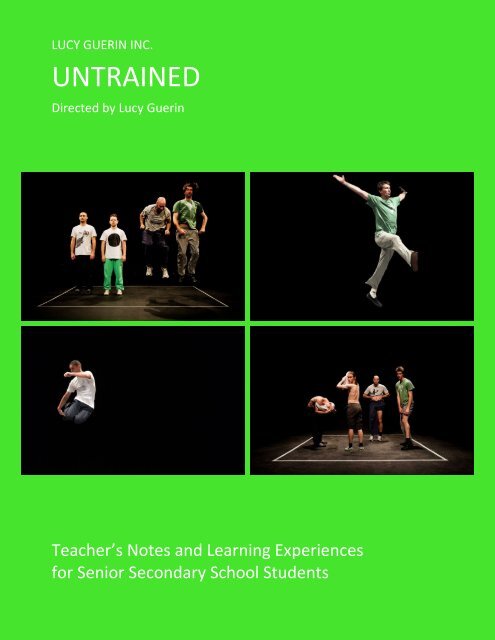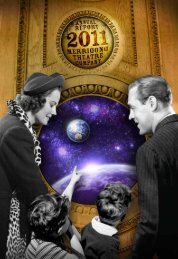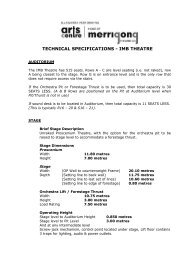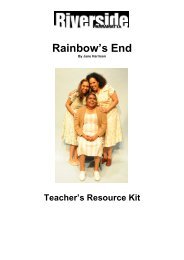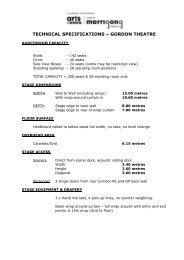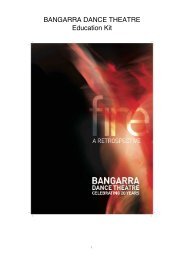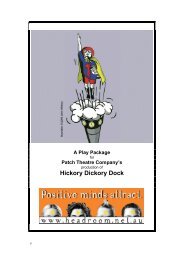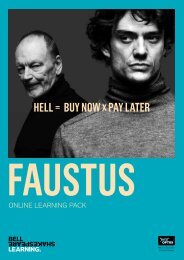UNTRAINED
UNTRAINED - Merrigong Theatre Company
UNTRAINED - Merrigong Theatre Company
- No tags were found...
Create successful ePaper yourself
Turn your PDF publications into a flip-book with our unique Google optimized e-Paper software.
LUCY GUERIN INC.<br />
<strong>UNTRAINED</strong><br />
Directed by Lucy Guerin<br />
Teacher’s Notes and Learning Experiences<br />
for Senior Secondary School Students
Untrained<br />
Four men perform this work. Two of them are highly skilled, experienced dancers and two have no<br />
movement training whatsoever.<br />
Untrained questions our ideas about what is worth watching in a performance. The complex, refined<br />
movements one can do with ease, another can only try and approximate.<br />
All performers are given the same instructions. How they execute them constructs an individual<br />
portrait of each man and also an unavoidable comparison between them. This evolution of<br />
information, built up through units of action, points out what they have in common and where their<br />
physical histories set them apart.<br />
Not your average contemporary dance performance, Untrained is described by its director,<br />
choreographer Lucy Guerin, as a “theatrical exploration”. The work began as a workshop exploring<br />
Lucy’s interest in choreographing for non-dancers. What emerged is a rare and funny insider’s view<br />
into dance as an art form – which, at the same time, demonstrates how our everyday moves expose<br />
who and what we are.<br />
Lucy Guerin Inc.<br />
Lucy Guerin Inc. is a Melbourne-based contemporary dance company established in 2002 to create<br />
and tour new dance works. Renowned for the skill and originality of its small group of performers, it<br />
is a flexible organisation dedicated to challenging and extending the art of contemporary dance.<br />
The company is committed to the exploration of everyday events and the redefinition of the formal<br />
concerns of dance. New productions are generated through an experimental approach to creative<br />
process and may involve voice, video, sound, text and industrial design as well as Guerin’s lucid<br />
physical structures. Crucially, this is always a choreographic exploration, striving for visual, emotional<br />
and physical revelations that could not be generated or communicated in any other artform than<br />
dance.<br />
Lucy Guerin Inc. has been a major influence on the growing identity of Australian dance which stems<br />
from the company’s programmatic research into choreographic practice supported through several<br />
initiatives.<br />
2
Director’s Notes<br />
Lucy Guerin<br />
Untrained is a collaborative work devised by two trained dancers, two performers with no dance<br />
training and myself.<br />
Initially in Untrained, I was interested in how non-dancers dealt with choreographed dance steps. It<br />
brought up the question of what we most respond to in a performance. Is it people doing<br />
remarkable things that as an audience member we could never achieve, or our ordinary selves<br />
reflected back at us in a new context?<br />
Untrained is not a dance in the traditional choreographed sense where dancers learn set movements<br />
and do the same thing every time they perform it. Each performer responds to a list of written<br />
instructions and depending on whether they have had a dance background or not, and on their<br />
physical histories their responses to the instructions are different, essentially revealing their physical<br />
natures and to a degree their personalities and the way they approach their lives.<br />
Over the course of making the work we all contributed to the pool of instructions, many of which<br />
showed not only the differences in how the men danced, but in how they did many other things in<br />
which none of them were trained. For the dancers, it seemed that their thinking and the way they<br />
tackled almost everything was explored through the connection they had with their bodies and how<br />
it had been trained. For the non-dancers, it was a leap into the unknown requiring courage and a<br />
sense of humour, with no experience to draw on to achieve the tasks.<br />
We feel admiration for the dancers and non-dancers alike, for different reasons. But whether they<br />
could dance or not, what clearly emerges is a portrait of each man, arrived at through an<br />
examination of their physical selves.<br />
Special thanks to Byron Perry, Antony Hamilton, Ross Coulter and Simon Obarzanek,<br />
the original cast of Untrained.<br />
3
Education Resources Materials<br />
These education resource materials are aimed at supporting teachers of Senior Secondary students<br />
with both pre and post performance activities. The learning experiences presented in this kit support<br />
an integrated approach to the use of the creative arts in the classroom as well as dance/movement<br />
and drama as an art form approach to appreciating and responding to performance.<br />
Broadly, four key learning areas are targeted in these resource materials – English, Creative Arts<br />
(Dance, Drama, Music & Visual Arts), Science and Technology and Personal Development, Health and<br />
Physical Education. The detailed notes are designed for Senior Secondary students however students<br />
in younger years would also benefit and these activities can be adapted including a altered level of<br />
expectation and outcome.<br />
These materials are designed to be ‘teacher-friendly’ guiding you through step-by-step learning<br />
experiences for your students. In addition, suggested classroom management strategies for doing<br />
dance/movement in the classroom have also been included to assist with the implementation of the<br />
activities included in this resource kit.<br />
A Note on Contemporary Dance<br />
The movement work in Untrained, along with much contemporary dance can be viewed as fairly<br />
abstract for less experienced audiences. Attending a performance with an appropriate expectation<br />
of contemporary dance, as well as understanding the history and aim of a particular piece, will allow<br />
for maximum enjoyment to be gained from the experience.<br />
These education resource materials provide a way to engage student interest prior and post the<br />
performance and explore their expectations and understanding. In addition, it provides a theoretical<br />
and practical exploration of the work itself allowing for the ‘journey’ being expressed through<br />
movement to be considered.<br />
We highly recommend that teachers engage their students in the pre-performance activities and<br />
make themselves aware of the history and style of performance they will be attending. By doing so,<br />
all can share an enjoyable and meaningful theatre experience.<br />
4
Classroom Management Suggestions<br />
Dance/Movement and Drama can be used to enhance classroom-based learning by providing<br />
opportunities to explore ideas and issues in different, expressive ways. Engagement in the creative<br />
arts, including dance/movement and drama, has been considered to assist with the development of<br />
self-esteem, communication skills, problem-solving abilities, and in the development of focus and<br />
team building through fun activities.<br />
Incorporating dance/movement or drama in school classrooms presents a number of challenges for<br />
teachers, but when attempted reaps many rewards for all involved. The following suggestions are<br />
designed to provide some food for thought in relation to working in these areas and are intended as<br />
a guideline only.<br />
When doing dance/movement or drama in the classroom:<br />
- ensure a clear work space is available for the activity (with mats laid if possible). If desks can<br />
not be moved in the classroom, try to use the hall or outside open area.<br />
- talk to the students about the creation of a ‘safe space’. In this space students don’t laugh at<br />
each other, but support and encourage (forming a circle at the beginning and end of a session or<br />
sitting with eyes closed are simple ways to focus students for a session)<br />
- always begin every session with a warm-up. This should include a physical warm-up, but it is<br />
also helpful to begin with a focus/team building activity. There are good books and websites<br />
available with suggestions of warm-up activities and focus games e.g. http://learnimprov.com/<br />
(then go to warm-ups)<br />
- incorporate a reflection session at the end of every activity. This allows the students to<br />
consider what has been done and take more meaning away from the activity than it just being<br />
fun (which it will be!)<br />
- be firm with the students. If a student does not follow instructions, they should be removed<br />
from the activity. This will allow the other students to see that you as the teacher are assisting in<br />
maintaining the safe space for them to work.<br />
- don’t be afraid to participate in the activities yourself. The students like to see you as the<br />
teacher taking a role in an activity. This can also allow you to help any students through<br />
modelling.<br />
If possible, conduct a ‘risk assessment’ with your class before embarking on any physical work. As<br />
class it would be good to discuss the personal, group, physical, and psychological risks inherent in<br />
the working space. Together, the class could devise the measures that would help to minimize these<br />
risks. This collaboration would help the students to realise that physical work can actually be<br />
dangerous, and encourage them to take responsibility for themselves, the group, and the space<br />
they’re working in.<br />
5
Teacher Resource Activities for Untrained<br />
These activities are suggestions only and teachers are strongly encouraged to adapt or alter suggestions to suit their schools and individual classrooms. The<br />
activities outlined below are designed for Senior Secondary students and include cross-curricular activities as well as some activities specific to the artforms<br />
of drama, dance.movement. While there is some natural flow between these activities, it is not critical that activities are completed in the order presented<br />
under ‘Post Performance’.<br />
Pre Performance<br />
Introduction to Untrained<br />
Topic/Theme Learning Experiences<br />
Introduction to<br />
‘Untrained’<br />
1. Display the word - Untrained. Divide students into small groups for a brainstorming session.<br />
2. Ask each group to brainstorm what this word evokes for them. Encourage students to include response to the word as a ‘title’ as<br />
well as what it may mean in general usage. (Record these for later reference.)<br />
3. As a whole class, groups are to share their thoughts. Elicit from students what they believe a performance inspired by this word<br />
might include.<br />
4. Elicit from students their understanding of the word ‘postmodernism’. (See the following links for definition if required -<br />
http://en.wikipedia.org/wiki/Postmodernism_in_the_theatre, http://en.wikipedia.org/wiki/Postmodern_dance) They should also<br />
consider what ‘postmodernism in theatre and dance’ might refer to.<br />
5. Discuss the following quote from Lucy Guerin regarding the connection between ‘Untrained’ and ‘Postmoderism in dance’ (refer<br />
also to the review –Appendix A – by Alison Croggan in relation to this connection):<br />
People have been using Untrained bodies in dance since the sixties so this is nothing new. In fact these elements of chance, pedestrian<br />
movement, lack of theatricality are now firmly embedded in contemporary dance practice. Recent European conceptual dance (Jerome<br />
Bel, Xavier Leroy,) has its roots in the work of the artists of the Judson Church. I think one of the main things Untrained has in common<br />
with the post modernists is that it is asking questions about the act of performance and what is interesting to watch for an audience.<br />
NB If you wish to engage more fully with the history of postmodernism and dance, students could spend some time researching this<br />
era. Discussion can be encouraged drawing from their research and focusing their thoughts on what a production that is reminiscent of<br />
postmodernism in dance may entail.<br />
6. Review student expectation of the performance based on this information, reinforcing the unique nature of the performance which<br />
is more about movement and expression that a complex choreographed dance work.<br />
6
Introduction to Performance<br />
Topic/Theme Learning Experiences<br />
Introduction to<br />
performance<br />
1. Elicit from students their past experiences of attending a performance (dance/movement in particular). Discuss expectations in<br />
relation to being an audience member in this style of professional performance.<br />
2. Brainstorm with students the differences between dance/movement they would do in their classroom/school and the<br />
‘dance/movement’ that is viewed as performance. Also consider specific expectations of an audience member in a live performance.<br />
3. Discuss the meaning of ‘contemporary dance’ – consider the inclusion of speech, sound, music within performance. Elicit from<br />
students their expectation for a ‘contemporary dance’ performance.<br />
NB Draw on definition and notes provided earlier in these resource materials to help with establishing an appropriate expectation for<br />
the performance.<br />
Post Performance<br />
Theatre Evaluation & Response (Integrated)<br />
Topic/Theme Learning Experiences<br />
Evaluation &<br />
Response<br />
1. Students discuss response to the performance as a whole considering themes, style and personal impact. Discussion to focus<br />
particularly on their personal and emotional response to the performance.<br />
2. Students to write a review of the performance with language and structure appropriate to publishing in a newspaper. It would be<br />
important to discuss the style of writing appropriate for newspapers, provide students with some examples of theatre reviews as a<br />
model for their work.<br />
3. Publish the written reviews. Consider placing best reviews in the school newsletter or submitting them to the local paper.<br />
7
Response through Visual Representation<br />
Topic/Theme Learning Experiences<br />
Response through<br />
Visual<br />
Representation<br />
1. Students to discuss their reaction to the performance and decide on the dancer/performer to which they most relate.<br />
2. Students to create an artwork representing their emotional response to this performer and their part in the production. Students<br />
should consider colour, line, shape and mood as well as a title. The title of the piece should be incorporated in the artwork.<br />
NB Students should be encouraged to plan their work (design) and use multi-media/digital techniques where possible<br />
3. Students to explain their artwork to the class justifying their choice of materials and style.<br />
Introduction to Contemporary Dance exploration (Movement)<br />
Topic/Theme Learning Experiences<br />
Introduction to<br />
Contemporary<br />
Dance Exploration<br />
Blended shapes<br />
1. Establish a ‘safe space’ where the following activities will take place. Ensure all students understand importance of respecting all<br />
interpretations by their colleagues during these activities.<br />
2. Conduct physical warm-up with students. (Refer ‘Classroom Management Strategies’ offered earlier in these notes)<br />
Make sure the area you are working in is clear with adequate space for the following movement activities<br />
3. General Movement/Body Awareness Activities (for both activities emphasise the importance of varying speed, height and direction)<br />
• Ask students to wander around the space<br />
• Ask students to play a game of ‘follow the leader’<br />
4. Improvisation Activities<br />
• Introduce the game “What am I doing?” to the students. In this game students sit in a circle, one student is in the middle of the<br />
circle miming an activity e.g. brushing my teeth. Another student asks them what they are doing. The student miming should<br />
reply a different action to what they are doing e.g. walking the dog. The new student then gets up and mimes this new activity.<br />
This continues until all students have had a turn.<br />
• Play the game “Space Jump” with students. Also done in a circle, in this game a student in miming an activity. After a short<br />
time the teacher should call ‘Space Jump’. The student in the circle is to freeze. At this time, another student should enter the<br />
circle and begin a new mime based on the frozen position of the original student.<br />
NB I would not recommend going higher than about 4 students when attempting space jump for the first time.<br />
1. Ask students to form into groups of 5 - explain activity. Students will be working together to create shapes that complement each<br />
other. e.g. if one student is in a ball, the next may curve over their back. Choose one group to begin the activity as an example.<br />
2. Students to work on activity aiming to have all members in complementary positions<br />
3. Repeat activity using contrasting shapes.<br />
NB Having images of complementary and contrasting shapes may help students understand how to complete this activity.<br />
8
Performance Reflection & Humour<br />
Topic/Theme Learning Experiences<br />
Performance<br />
Reflection &<br />
Humour<br />
1. Elicit from students some of the sequences the performers completed during the performance. The following list can be used as a<br />
prompt.<br />
• Movement for name (forward/reverse)<br />
• Standing on one leg<br />
• Falling in slow motion<br />
• Follow the leader<br />
• Eating<br />
• Sleeping<br />
• Series: running race beginning, jumping, leaping, star jump<br />
• Taking off/putting on a shirt (with articulation)<br />
• Taking multiple roles in a short script<br />
2. Students should be encouraged to brainstorm their own activities to add to/replace this list. It would be helpful to explain to<br />
students that this was how the piece was originally devised. All performers contributed different kinds of activities and executed them<br />
one at a time or as a group. When the show is recreated with new ‘untrained’ in each place, some new instructions will then be<br />
developed with them which relate to their specific occupations and interests.<br />
3. Discuss what expectations students would have of a dancer - do they consider these to be complex actions/sequences? What<br />
differences did they notice between the dancers/non-dancers in each?<br />
NB Important to reflect on initial pre-performance discussions of what ‘trained/untrained’ might mean<br />
4. Encourage students to reflect on the aspects of the performance they found to be humorous. The following questions may help<br />
prompt discussion.<br />
• Why did they believe that the ‘untrained’ dancers appeared more comic than the ‘trained’ dancers?<br />
• What triggered laughter – a visual comic stimulus or embarrassment as an audience member?<br />
• Do they believe that any of the performers moved in particular ways to generate humour from an audience or did all attempt<br />
each sequence seriously and to the best of their physical ability?<br />
5. Explain to the students that they will be engaging in some of the same activities that the performers did in Untrained.<br />
6. Discuss the importance of a ‘safe space’ and conduct an appropriate warm-up before beginning any physical work with students –<br />
refer to Classroom Management strategies earlier in these notes<br />
9
NB Teachers should consider which option is most suitable for their class depending on the confidence and experience of the students<br />
Option 1 – Simultaneous exploration – each student does the activity/sequence at the same time<br />
6. Have the students find a space to do the series of activities listed above<br />
7. Teacher to call out each action outlined above and students to do them in their own space<br />
Option 2 – Students do each activity/sequence in small groups with other students watching<br />
6. Students to be in groups of no more than four. One group to be selected while the others watch as ‘audience’.<br />
7. Each group in turn to rotate being the ‘performers’ and doing the series of actions outlined above<br />
8. Students to discuss how it felt to do the different actions. The following questions may help prompt discussion.<br />
• Were some actions harder than others?<br />
• What did doing basic actions tell them about the way their own bodies moved?<br />
• Had they thought about simple things like how they slept or putting on a shirt before?<br />
9. What did they learn about others through watching their simple movements? Did it change their understanding of how they<br />
interact with others?<br />
Nature of Performance<br />
Topic/Theme Learning Experiences<br />
Nature of<br />
Performance<br />
1. Students to consider the following quote:<br />
“I can take any empty space and call it a bare stage. A man walks across this empty space whilst someone else is watching and this is<br />
all that is needed for an act of theatre to be engaged”<br />
(Peter Brook, 1968 p9)<br />
2. Ask students to work in pairs and discuss this quote in relationship to:<br />
a) their own experiences of viewing performances/theatre<br />
b) how this relates to/sheds light on the production of Untrained<br />
c) how this quote/perspective might shape their understanding of the question, ‘What is performance?”<br />
Each pair to do the following activities based on their understanding of what performance is.<br />
3. Pairs to brainstorm words, images and anecdotes to represent their understanding of performance.<br />
4. These should then be swapped with another pair. The alternate pair is to highlight five of the words, images or anecdotes they<br />
believe represent most clearly an understanding of performance. They then give these back to the original pairs.<br />
5. The original pairs are to consider the five selected words, images or anecdotes and match these with colours.<br />
6. Pairs are to create a visual arts piece displaying the five words and appropriate colours to portray their understanding of<br />
performance.<br />
NB These could be displayed along with the original words, images or anecdotes that inspired them if desired.<br />
10
7. Students are to consider the words and colours and in pairs develop a series of five physical images to represent what inspired<br />
them. Encourage students to draw on natural movements, line and shape as well as focusing on mood and level.<br />
9. If desired, students can perform their five physical images as a stimulus for discussion on the varying answers to the dilemma –<br />
‘What is performance?’<br />
What is Drama?/What is Dance/Movement?<br />
Topic/Theme Learning Experiences<br />
Debate –<br />
Dance/Movement<br />
or Drama?<br />
1. Elicit from students what they believe was the inspiration for Untrained. Consider the title as well as referring to pre-performance<br />
thoughts for this piece.<br />
3. Explain that the students will be taking part in a debate arguing either that Untrained is predominantly a drama piece or<br />
predominantly a dance piece.<br />
4. Allocate students groups and either the dance or drama focus<br />
5. Students should conduct research to ensure they consider Untrained through an understanding of:<br />
• the history of drama/dance,<br />
• characteristics of their allocated artform,<br />
• other examples which will support or refute their perspective<br />
• contemporary dance/movement and its role within the broader artforms of drama and dance<br />
Their research work should be recorded for use in their presentation/debate. Where possible, developing the presentation the use of<br />
technology should be encouraged.<br />
4. Each group is to present their information in 2 ways.<br />
a) Through a verbal/multimedia presentation drawing on the areas outlined in point 5 (above) arguing their perspective<br />
b) Through a ‘frozen image’ representing what group feels is the essence of Untrained as either dance or drama.<br />
NB If students have not done ‘frozen images’ before - explain they are to create a real life photograph using their bodies.<br />
5. Schedule each group’s performance and presentation. Following each image, the class should discuss the elements of drama or<br />
dance displayed in the image.<br />
6. At the conclusion of all presentations, encourage a class discussion regarding the relationship between drama and<br />
dance/movement as represented in Untrained.<br />
11
Reflection and Exploration of Self and Identity<br />
Topic/Theme Learning Experiences<br />
Reflection and<br />
Exploration of Self<br />
and Identity<br />
1. Ask students to listen to the following quote:<br />
The evolution of information about each man, built up through units of action, points out what draws us together and what sets<br />
us apart as individuals.<br />
(Explain that this is a description of ‘Untrained’ as provided in marketing materials by Lucy Guerin Inc.)<br />
2. Discuss what this quote evokes for the students understanding of the performance. What differences did they believe there were<br />
between the performers? Did they view them as ‘individuals’ or as part of a ‘team’ involved in a common production?<br />
3. Divide students into four groups with each being allocated one performer. Students are to reflect on two areas and provide<br />
examples:<br />
• What do they believe their particular performer did within the production to contribute to an audiences understanding of<br />
their personal identity?<br />
• Do they believe that the ‘identity’ being revealed on stage was a construct or a reflection of true identity?<br />
4. Groups are to share their thoughts on their performer with the class to prompt more general discussion of identity and identity<br />
creation.<br />
5. Ask each student to record his or her thoughts about identity creation. The following statement could be used as a<br />
prompt/challenge to encourage reflection.<br />
Nobody ever shows their true identity, all we show about ourselves is constructed through our own ideas of who we wish to be,<br />
and believe those around us wish us to be.<br />
NB No student will be required to share their ideas if they do not wish to – they will be used, however as stimulus for the following<br />
activity.<br />
6. Students to use their reflection (either in agreement or opposition to the statement) as a stimulus for designing a multi-media<br />
sculpture OR physical tableaux. Students to be given the option as to which task they complete.<br />
NB It would be beneficial to have some pictures/examples of sculptures and physical tableaux for inspiration.<br />
Sculpture<br />
7. Students to develop a sculpture as inspired by their reflection – consider the use of a sculpture (portrait) in Untrained. In this<br />
activity, it does not need to represent a known object, and can be abstract.<br />
8. Students should follow proper design and make procedures (sketching design and deciding materials before beginning<br />
construction).<br />
9. Sculptures to be displayed - students to decide on an appropriate one-word title for their work.<br />
12
Physical Tableaux Series (NB students could draw on other classmates to assist in the presentation of the work, however the actual<br />
design of the physical tableaux series should be an individual activity)<br />
7. Students to create a series of three tableaux images to represent their reflection on identity creation. Line, shape and associated<br />
mood should be considered as well as the use of sound, costume, props etc (if relevant/available)<br />
8. Students should record either through sketches or drawings the series of images and be able to articulate the connection to their<br />
understanding of identity<br />
9. The Tableaux series to be performed - students to decide on appropriate one-word title for their work.<br />
NB Still images could be taken of each tableaux in the series and would be a good activity for setting up a still-art exhibition<br />
Portraits<br />
Topic/Theme Learning Experiences<br />
Portraits<br />
1. Discuss how portraits are used in Untrained e.g. drawn, video. The following questions may help to stimulate discussion.<br />
• What part of the body was used in the portraits? Is this typical?<br />
• What was different between the drawn and video portrait?<br />
• Why were the drawn portraits more similar than the video ones?<br />
• What do the students believe the performers were wishing to represent about themselves in the video portraits?<br />
NB A digital video camera is required for the following activity – if one is not available, students can create a photograph instead of a<br />
video with a digital stills camera. If no camera is available, the activity can be modified to doing drawn portraits only, and bringing a<br />
photograph from home.<br />
2. Students to work in pairs and select either ‘drawn portrait’ or ‘video/photographic portrait’. (If desired, all students could do both<br />
style of portrait if time allows.)<br />
13
Drawn Portrait<br />
3. Students should work in their pairs to draw a portrait of each other’s face with the ‘drawer’ emphasising elements of their partner’s<br />
personality they find most appealing - a variety of materials could be used for this activity - crayons, pencil, charcoal, paint etc<br />
4. Pairs should compare the portraits and discuss the areas emphasised/focused on to gain an understanding of the way they are<br />
perceived by their partner.<br />
5. Pairs should then reflect on how this compares with their own perception of what may be appealing about themselves<br />
Video/Photographic Portrait<br />
3. Students to discuss one thing they believe typify themselves. In pairs, students should plan a video sequence or photograph of their<br />
face that allows for that aspect of self to be revealed.<br />
4. Pairs should take the photographs/shoot the video, and upload them for further discussion.<br />
5. Pairs should reflect on their videos/photographs and how their plan actually translated into image – did it show what they hoped?<br />
Did the video or photograph reveal anything they were not expecting?<br />
Pairs to swap images with a pair from the other option (drawn/video or photographic) for the following activities.<br />
Wider response to image<br />
6. Ask students to recreate one of the two photographs or capture a still from the video considering lines, shapes, overall<br />
composition. Various media can be used for the recreation including pencil, crayon, charcoal or paints.<br />
Detailed response<br />
7. Provide each student with a toilet roll (if not available, a rolled up piece of paper will also work). Instruct students to look through<br />
their roll and focus on one part of their chosen image (drawn/photographic). Through lines and shading, students to recreate only this<br />
small section as a complete artwork. (Similar media to the wider response to be used for this activity)<br />
8. Students are to consider their two pieces of artwork and brainstorm words they feel complement each piece. Students are to<br />
choose an appropriate colour and create a border for their artwork on which their selected words have been printed.<br />
NB These borders can be created via a computer if desired.<br />
14
Collective Discussion<br />
9. A ‘Drawn Portrait’ and ‘Photographic/Video Portrait’ pair should be brought together to make a group of four. In these teams,<br />
students should consider all four images and discuss the different aspects of ‘identity’ and ‘self’ that are revealed.<br />
10. The teacher should then ask each team to consider the following question and prepare a response to share in a whole class<br />
discussion.<br />
If these portraits were to include the whole body and not just the face, what other information may or may not be given and<br />
might this change our understanding of personality?<br />
Teams should be encouraged to consider the impact of body language on our understanding of self and identity. In addition, students<br />
should be encouraged to consider how body language can be used to alter other’s perceptions of ourselves as well as help us<br />
understand other people, their emotions and feelings.<br />
11. Teams should report their ideas to the whole class and this information should be used as a stimulus for whole class discussion.<br />
15
<strong>UNTRAINED</strong>: REVIEWS<br />
Foursome create sublime mix<br />
Adelaide Advertiser<br />
26 February 2010<br />
Reviewed by Peter Burdon<br />
LUCY Guerin's Untrained is a hugely enjoyable work, bringing together and fully exploiting<br />
the theatrical potential of two superb dancers and two other artists from outside the<br />
performing sphere.<br />
Untrained incorporates a basic movement vocabulary and a great deal of improvisation,<br />
much of which is very amusing, as in the sequences where the untrained attempt to mimic<br />
the trained, a formidable challenge when either of the dancers, Antony Hamilton and Byron<br />
Perry, let loose.<br />
It's a mark of the respect the four performers have for each other that the untrained, visual<br />
artists Ross Coulter and Simon Obarzanek, are not belittled by their manifest inability to<br />
match the phenomenal skill of two of Australia’s best dancers.<br />
If the challenge for the untrained is great at times, the trained don't get it all their own way.<br />
Two scenes where Obarzanek and Coulter improvise on the dancers, especially Obarzanek's<br />
live photograph are taxing in the other direction.<br />
The delight of all four performers is both evident and infectious, to the extent that Perry, in<br />
particular, failed entirely to keep a straight face at the hilarious attempts to keep up with<br />
the dancing Joneses. Laugh, and the whole world laughs with you.<br />
The sole set piece of the night, a closing quartet, is a stroke of genius, bringing the trained<br />
and untrained together in a show that was otherwise a very individual affair.
Amateurs take the spotlight, steal laughs<br />
Sydney Morning Herald<br />
4 September 2009<br />
Reviewed by Jill Sykes<br />
This is fun. Not, perhaps, for people who expect an evening of serious innovative dance<br />
when they buy their tickets. But for regular dancegoers who enjoy something different, who<br />
are prepared to have questions asked and to ask their own, Untrained is refreshing and<br />
amusing.<br />
As its title suggests, it involves two untrained dancers alongside two who have been dancing<br />
most of their lives, Byron Perry and Luke Smiles. Simon Obarzanek (brother of the<br />
choreographer Gideon) and Ross Coulter, in contrast, have neither training nor any obvious<br />
instinct for dance.<br />
The four of them line up as they might in a traditional dance class when each person<br />
performs a required movement or phrase. These are not usually the same, just similar. But<br />
when Obarzanek and Coulter do them, the results are often hilarious. Yet as we laugh - and<br />
the whole thing is done in high good humour - we can observe the stark differences in body<br />
shapes and control, in the ability to move and communicate through dance. I love watching<br />
amateur dancers doing something they love in circumstances where that passion guides<br />
their action. But this is something else.<br />
Obarzanek and Coulter cope intelligently with their lack of skill in jumps, tumbling falls and<br />
turns, and it is fascinating to observe how they compensate. The guys who can't do it<br />
become more interesting than the two who can. They have the audience's sympathy and<br />
admiration for their truly creative efforts.<br />
Director Lucy Guerin has not gone so far as to ask the polished dancers Perry and Smiles to<br />
perform poker-faced and characterless, so there is not that degree of contrast. And you<br />
have to wonder: what would she have done if the untrained performers had started to get<br />
better? Told them to stay as they were?<br />
As the piece evolves, the dancers pair off and take it in turns to follow the other. It is<br />
probably the peak of the action in its highs and lows of achievement and failure, though the<br />
brief finale with all four is pretty good. In fact, the ''untrained'' are in danger of looking not<br />
so bad.<br />
http://www.smh.com.au/articles/2009/09/03/1251570799835.html
Dance Massive: Untrained<br />
Theatre Notes<br />
March 17 2009<br />
Reviewed by Alison Croggon<br />
Lucy Guerin's Untrained, presented in the dance-friendly space at the Meatmarket, is<br />
another take on command and response. The premise is lucid and simple: four performers,<br />
two trained dancers (Antony Hamilton and Byron Perry) and two untrained (visual artists<br />
Ross Coulter and Simon Obarzanek), are given a series of tasks, which they perform before<br />
an audience. The tasks are listed on pieces of paper laid on the floor, and the performances<br />
take place in a small square outlined in the middle of the stage.<br />
It could be the essence of banality, a merely intellectual examination of the differences<br />
between levels of performative skill. Indeed, before I saw it, I read this withering review in<br />
the Age, which said that the work was simply going over old ground broken in the 1960s,<br />
and that although it was "mildly entertaining", Untrained was "ultimately uninteresting".<br />
Ouch.<br />
After I had seen the show, this struck me as a rather ungenerous response: as with Two-<br />
Faced Bastard, I think you have to work hard to resist the unexpected charm of this show.<br />
But the review prompted me do some reading about the post-modern dance that emerged<br />
in 1960s New York. Post-modern dance evolved in part from the dance of Merce<br />
Cunningham, although it was a reaction to the purities of modern practice. It famously<br />
began with an influential series of performances in the Judson Church Hall in Greenwich<br />
Village in the early '60s. And yes, Jordan Beth Vincent is quite correct: Untrained is indeed<br />
in the same area. Like those performances, this show draws on Dadaist influences, Cagean<br />
randomness and task-based activity, and the vernacular of the everyday, using both trained<br />
and untrained bodies to examine the nature of performance.<br />
Does this mean Guerin is merely reinventing the wheel? Is it naive to find it engrossing? I'm<br />
not so sure. For one thing, you'd have to be absolutely certain that Guerin doesn't know<br />
that the wheel exists in the first place. Myself, I'd be taking bets that she is perfectly aware<br />
of the traditions from which she is drawing. And also, you'd have to ignore the immediacy<br />
of the performances, which engage your attention throughout the show (which seemed a<br />
lot shorter than its 90 minutes). I thought of Borges's story about the man who rewrote<br />
Cervantes' Don Quixote, and his assertion that, although the second text was exactly the<br />
same, word for word, as the original, the newer writing was an entirely different work,<br />
because an entirely different time and series of necessities had brought it to fruition. I think<br />
some- thing similar pertains here. Only more so, because performance only ever exists in<br />
the now.
What emerged from this series of tasks, ranging from the mundane - say your name<br />
backwards - to the comic - do a slow-motion fall - was a surprisingly moving process of<br />
personal revelation. You would expect the non-dancers to be vulnerable, exposed by their<br />
lack of skills when juxtaposed with such skilled bodies as Perry and Hamilton; what you<br />
might not expect is the vulnerability opened in the dancers as the visual artists began to<br />
exploit their comedic incompetence to charm the audience.<br />
More than anything else, Untrained is four very intimate portraits. Portraiture is an overt<br />
theme: during the course of the show the performers drew pictures of each other, as well<br />
as speaking to paper sculptures that were self-portraits. The show is almost cubist in the<br />
way it opens out differing perspectives of looking (I guess it's no accident that two<br />
performers are visual artists) - we are aware of the performers looking at each other as well<br />
as us looking at them, and of the differing expectations with which we look.<br />
It demonstrates how revealing movement is, exposing a person's shynesses and extrovert<br />
defences as well as their generous expressiveness. And it shows how expressiveness<br />
expands through play, opening up privacies of which the performers are not necessarily<br />
conscious. A young girl in front of me was enchanted and shook with laughter all the way<br />
through it; it was certainly funny, but that transparent comedy was gently underlaid by<br />
something else, some- thing profoundly humane, which was much more complex than it<br />
seemed.<br />
Untrained: Concept/ Direction: Lucy Guerin, Performers: Ross Coulter, Antony Hamilton,<br />
Simon Obarzanek, Byron Perry.<br />
http://theatrenotes.blogspot.com/2009/03/dance-massive-lawn-rogue-untrained.html
Untrained | Lucy Guerin Inc<br />
Australian Stage<br />
13 March 2009<br />
Reviewed by Simonne Michelle-Wells<br />
Untrained, a new work by choreographer Lucy Guerin and part of the first Dance Massive, is<br />
a wholly satisfying theatre experience. It calls itself a ‘casual theatrical exploration’; an<br />
entirely appropriate summation of a show that’s a fascinating combination of dance,<br />
theatre, improvisation and multimedia, all presented with just the right amount of quirk<br />
and irreverence.<br />
Untrained presents the audience with four performers: two trained dancers (Byron Perry<br />
and Antony Hamilton) and two professional visual artists with no dance training whatsoever<br />
(Ross Coulter and Simon Obarzanek). The basic premise here is that all four are asked to<br />
perform the same instructions. How they execute these then creates individual portraits of<br />
each performer, as well as allowing for comparisons between them. As the show progresses<br />
and we are given more information and further insights into each performer, we see their<br />
commonalities as well as their differences, as performers and as people.<br />
The piece doesn’t become, however, merely a simple exploration about difference; it’s also<br />
about art itself: about what it means to watch a performer and what is really worth<br />
watching in a performance. This is the basis of what is truly unique about Untrained. It was<br />
hard to gauge what was improvised and what wasn’t, and there were some sequences that<br />
left you wondering why on earth you were watching four men do that, while, at other<br />
times, the audience erupted into spontaneous applause because what they offered was so<br />
theatrically engaging and somehow simultaneously so intensely personal it was very<br />
moving.<br />
Byron Perry and Antony Hamilton are beautiful, seasoned dancers and a delight to watch.<br />
The attempts by Coulter and Obarzanek to match their movements, as well as providing<br />
huge amounts of comic entertainment and an insight into how untrained dancers use their<br />
bodies, also served to highlight their skill and grace a hundred- fold. Perry is mesmerising.<br />
His skills clearly extend beyond dance, since he displayed strong voice and theatrical skills<br />
too.<br />
Guerin says of the show, "In watching trained dancers I think we feel confidence about how<br />
the movements are executed and that they will be in control of what they are doing. The<br />
untrained dancers offer us a more precarious, unpredictable experience...there is an<br />
element of risk in their attempts."
Indeed, there were more than a few moments in the show where the audience held its<br />
collective breath as Coulter and Obarzanek attempted a few back spins and head slides<br />
across the floor. Watching the trained dancers, you had an expectation of where their<br />
movements would take them, not to mention the grace displayed in getting there, but with<br />
the untrained dancers, there was a big element of the unknown and a real sense of<br />
protection extended to them by the audience.<br />
Guerin also adds, "With non-dancers their movement training is their daily lives and their<br />
inherited physicality. So they are more able, in a way, to create movement that is ‘new' or<br />
undefined from a dance perspective; and that movement is very difficult to reproduce,<br />
even for a dancer."<br />
I’m not so sure about the “even for a dancer” bit. This sequence in the show, where first<br />
the untrained and then the trained dancers dance (improv) and the other has to mirror<br />
them, is a lot of fun. But the trained dancers were phenomenally good at copying the<br />
mostly unorthodox movements of the untrained dancers. It was surprising how precisely<br />
they actually could match such ‘undefined’ movements.<br />
There is a lot of joy in Untrained. The performers clearly have a good time. And why<br />
wouldn’t they? At one point Coulter (untrained) has a go at creating some choreography for<br />
Hamilton (trained) and tells him to ‘move like seaweed on the left side of your body and a<br />
robot on the right’ and somehow Hamilton does it and does it well! Later, each of the<br />
performers describes to the audience what their experience in collaborating on the show<br />
was like; Obarzanek says matter-of-factly, “They [the trained dancers] know what each little<br />
hair on their knuckle is doing, while it takes me half an hour to get my foot to move”.<br />
Untrained closes with a choreographed dance sequence, clearly rehearsed by all four<br />
performers beforehand, and this is a fabulous way to end the show. This not only<br />
counterpoints the improv con- tent, but also hints at the difference that can be made by<br />
practice for the untrained. I left wanting to sit down and see it all again. It’s wonderful,<br />
inimitable stuff.<br />
http://www.australianstage.com.au/reviews/melbourne/untrained--lucy-guerin-inc-<br />
2323.html
Nothing Hidden, Much Gained.<br />
RealTime<br />
March 2009<br />
Reviewed by Carl Nilsson-Polias<br />
The titles of Lucy Guerin’s recent works have been marked by clarity and transparency, even<br />
literalness. Structure and Sadness dealt with the aftermath of grief caused by the west gate<br />
bridge collapse. Melt was a duet for two water molecules that move from ice through to<br />
steam. Corridor limited itself to a long traverse stage and took a corridor scene from Kafka<br />
as its inspiration. And now Untrained juxtaposes two artists trained as dancers with two<br />
artists untrained as dancers.<br />
Contrast these examples with the titular and choreographic opacity of Shelley Lasica’s<br />
Vianne and there would appear to be nothing hidden in Guerin’s world, nothing that is so<br />
mysterious that it cannot be elucidated in a simple, perfectly decipherable title. For her<br />
critics, this is a cause for frustration: her works can be seen as the physical equivalent of<br />
begging the question in rhetoric, where the proposition assumes its own truth before being<br />
argued. In other words, is the dance redundant once you read the program notes?<br />
Yet, aside from the inherent value judgements involved in meriting metaphor over<br />
literalness, describing Guerin’s dance as redundant is to deny its capacity to transcend the<br />
admittedly literal text that tries to encapsulate it. Guerin is not given to ornateness in her<br />
language but her sensibility for the human form is far from plain—the duets across her<br />
body of work are remarkable in their mesmerising intimacy, their detail and their capacity to<br />
enliven the space between the dancers as much as they animate the bodies themselves.<br />
Moreover, by starting with such conceptual distillation, Guerin’s work emerges from a kind<br />
of purity, with every subsequent extrapolation seeming to fit and flow on perfectly from the<br />
last.<br />
Indeed, it is a questioning of purity that lies at the heart of Untrained. The title is easily<br />
decipherable, yes, but what is it to be untrained? Is the untrained body pure in its<br />
movement—unfettered by the conditioning of choreography and exercises? Or is it the<br />
trained body, in its refinement and exactitude, that achieves purity by sublimation? Guerin<br />
is certainly not looking for an easy solution to this dialectic. She is interested in what it does<br />
to us as an audience and to the performers themselves to see these questions made<br />
manifest by exploring the continuum from pure naivety to pure technique.<br />
Her staging of Untrained maintains this notion of purity. The set is nothing more than a grey<br />
playing square marked out by broad white lines. It is a clever delimiter, its form suggestive
of a playground ball court or a boxing ring—both stages perhaps but ones not restricted to<br />
the arts. The performers never leave our sight, yet, with just one exception, only when they<br />
enter this square are they viewed. This is no geometrical sleight of hand. What we are<br />
witnessing is an experiment where we are the lab technicians and this square our Petri dish.<br />
By placing contrasting physical presences in the same space one after another, Guerin<br />
provides us with a microscope through which to examine the idiosyncrasies, the likenesses,<br />
the differentiators and the foibles of four bodies in motion.<br />
The identities of these four bodies are important to note. Byron Perry and Antony Hamilton<br />
are two wunderkinder of the Melbourne dance scene. Not only are they ubiquitous<br />
presences in the works of Lucy Guerin Inc and Chunky Move, but they are also celebrated<br />
choreographers and visual artists. Their untrained co-performers are Simon Obarzanek and<br />
Ross Coulter, who are both visual artists. So, as it happens, all are men and all are visual<br />
artists.<br />
To begin with, the performers present themselves to the audience one at a time by<br />
standing in the centre of the square for a few seconds, doing nothing. They have been asked<br />
to be neutral. However, each of them carries a stamp of personality and of habit, and we<br />
see this. From this starting point, Guerin uses a succession of provocations to tease out<br />
different performative languages: sing a song, be a cat that gets electrocuted, copy your<br />
partner. At times, the audience laughs at the ineptitude of the untrained. At times, they<br />
laugh at the hubris of the trained. As the work progresses, the laughs dissipate and the<br />
analytical eye is no longer restricted to the audience—the performers themselves begin to<br />
reflect on how they compare with the others and, vitally, are asked to speak to their own<br />
image.<br />
Lucy Guerin Inc, Untrained, concept, direction Lucy Guerin, performers Ross Coulter,<br />
Antony Hamilton, Simon Obarzanek, Byron Perry, music Cusp by Duplo Remote, producer<br />
Michaela Coventry; Arts House, March 11-14; Dance Massive, Melbourne, March 3-15<br />
http://www.realtimearts.net/feature/Dance_Massive/9384
Reality Dance<br />
RealTime<br />
March 2009<br />
Reviewed by Keith Gallasch<br />
There are performance works that play with and disorient the senses—in Dance Massive,<br />
Simon Ellis and Shannon Bott's Inert, the Helen Herbertson-Ben Cobham Morphia series<br />
and Chunky Move's Mortal Engine; in recent theatre, Barrie Kosky's treatment of Poe's The<br />
Telltale Heart. At the same time, game and task-based works for performers and audiences<br />
are on the rise in live art events around the world, and in provocations such as Panther's<br />
exercises in happiness at the 2008 Melbourne International Arts Festival.<br />
These phenomena resonate, on the one hand, with the immersive media arts and virtual<br />
realities of the 21st century and, on the other, with computer game playing and the<br />
ongoing surge of popular competition, from quiz shows to reality TV. With none of the<br />
latter's dumbed down Darwinism, Lucy Guerin Inc's Untrained benignly offers us reality<br />
dance—an extended set of tasks that pit two trained dance artists (Byron Perry, Antony<br />
Hamilton) against two visual artists (Simon Obarzanek, Ross Coulter)—revealing much<br />
about how we perceive the human body and what we think we know about dance.<br />
The 'reality' of Untrained, however well constructed the overall work might be, is that the<br />
non-dancers' lack of dance skills provides a considerable likelihood of risk and of chance<br />
happenings, moments of surprising verve and sheer failure. Nor are the tasks simple for the<br />
trained dancers: there's a large quotient of improvisation and pas- sages where they have to<br />
closely mimic the unpredictable moves of the untrained or interpret their choreographies.<br />
As much as these amuse, they're also telling. The untrained pick up the broad patterns of<br />
movement, but rarely the detail (hinged on acute degrees of propulsion, balance and<br />
articulation), while the trained briskly realise additional layers of possibility.<br />
So, instead of a finished dance work, we are witness to a series of revealing portraits and<br />
tests with a chancy, cumulative impact. Above all, we are implicitly asked to look very<br />
closely at, and listen to, these four men, our role as observers considerably heightened.<br />
This is accentuated by the spare staging—a large open space with a square marked out in<br />
the middle, a frame in which everything hap- pens as soon as the men enter it from the<br />
queues they form either side. Initially, each man stands before us, motionless. We take<br />
each in. We'll subsequently see these same faces, these same bodies again, at rest (as if<br />
asleep), pulling faces, making weird sounds, reading aloud comments they've made about<br />
themselves. Towards the end, each of them simply stands before us again, but now we<br />
know more about them—not a lot (this is not the confessional faction of reality TV), but<br />
details of physiognomy and assessments of mobility, risk-taking, engagement with each
other and us. We have guessed at and largely learnt this not from the brief images of the<br />
men alone, but from their work together.<br />
There's even a moment where, with cards and textas, the men stand at the four corners of<br />
the frame and sketch each other's faces, then show the results to the audience. In another,<br />
they display photo- graphs of themselves, and elsewhere, videos they've directed. They<br />
even comment on each other's dance and visual art capacities. But it's the dancing itself<br />
which is most revealing. One after another the performers execute a move; as the image<br />
mutates the effect is of a visual Chinese whisper. More brief moves—balances, kicks, spins,<br />
painfully slow motion extensions—ensue and morph. Ross Coulter wittily removes his shoe<br />
and uses it puppet-like to mimic a slow motion fall while his body remains at rest. The tasks<br />
grow more demanding, if leavened with moments of yawning or sighing, or long jumps, or<br />
solo songs or speaking backwards, or performing favourite pop culture figures. The<br />
extended copying duets break the frame as each trained performer follows an untrained<br />
around the space and then the roles are reversed—concentration, effort, surprise and<br />
amusement are palpable.<br />
These competitive duets tell us much. Obarzanek tries very hard, he's a bit of a performer<br />
(naturally inclined to dance when he sings in his emphatic baritone); Coulter is economical,<br />
more low key, laconic, if nonetheless committed. With the trained dancers the differences<br />
are subtler; theirs is an easy-going naturalism, the singing more polished, personalities less<br />
overtly expressed. Not surprisingly it's their dancing which is telling: Perry's spring-loaded,<br />
quietly dramatic articulacy, Hamilton's sinuous, rippling intensity.<br />
As well as the duets, there's recurrent group work which comes affectingly into its own at<br />
the end—where you find yourself wishing that there'd been more of it, as big a demand as<br />
that might be. In the course of the show, the group moans, cries and, among other things,<br />
demonstrates various, revealing techniques for removing and putting on t-shirts. Above all<br />
the men collectively convey an undemonstrative competitiveness, mutual empathy and<br />
good humour as they perform their long list of tasks, while the audience doubtlessly<br />
reflects on what its own dance abilities might be in the same circumstances.<br />
Perhaps, too, the audience think about the pleasure of witnessing a benign image of men<br />
collaborating and competing without corporate, militaristic and sporting straitjacketings.<br />
However well or not they can dance, these men flow, as Klaus Theweleit put it in his antifascist<br />
classic Male Fantasies (1977), and the sense of them as real and complex, beyond<br />
artifice, is rooted in the lucid pragmatism of Guerin's task-based formulation for Untrained.<br />
http://www.realtimearts.net/feature/Dance_Massive/9382
What is dance? An old question is not always a good one<br />
The Age<br />
13 March 2009<br />
Reviewed by Jordan Beth Vincent<br />
In New York City in the 1960s and 1970s, a group of post-modern dancers set about<br />
redefining their art form by asking the most basic question: what constitutes dance?<br />
Key aspects of their choreographic and artistic explorations included using untrained<br />
performers, a democratic choreographic process, and rejecting traditional forms and<br />
structures.<br />
Nearly 40 years on, Lucy Guerin does her own exploration of those concepts in Untrained, a<br />
work that — considering the long history of such explorations — feels dated. The premise is<br />
simple: four men appear onstage, two of whom — Byron Perry and Antony Hamilton — are<br />
trained dancers. The other two — Ross Coulter and Simon Obarzanek — are visual artists,<br />
meaning that they bring a certain level of artistic awareness and creativity to the<br />
performance, yet have no physical training.<br />
There is a strong sense of a rehearsal-in-progress, an impression confirmed by the casual<br />
costumes of trackies and runners, as well as minimalistic lighting. The men take turns<br />
performing a series of tasks, each designed to create a portrait of the individual performer.<br />
Some are as simple as acting out a favourite movie scene, while others are slightly more<br />
intimate. There are some amusing moments, mostly surrounding the fumbled and clumsy<br />
attempts by Coulter and Obarzanek to imitate the complex movement patterns of Perry and<br />
Hamilton.<br />
Untrained succeeds in exposing some sort of truth about each of these performers. These<br />
are real men, who deserve to be commended for their brave willingness to reveal their<br />
insecurities, vulnerabilities and idiosyncrasies to an audience.<br />
Unfortunately, the piece never develops past the comparison between dancer and nondancer,<br />
even as it tries to emphasise the fallacy of such a distinction. Untrained fails to<br />
break any ground and, although seeing it may be mildly entertaining, this work is ultimately<br />
uninteresting.<br />
http://www.theage.com.au/articles/2009/03/12/1236447401936.html
Spring Dance festival looks to have legs<br />
The Australian<br />
22 September 2009<br />
Reviewed by Deborah Jones<br />
SYDNEY Opera House's new Spring Dance festival should be a stayer. In its first year the<br />
program has been small but well chosen.<br />
...<br />
Lucy Guerin's Untrained puts together two dancers and two artists, men completely<br />
untrained in dance. Guerin, isn't, however, revisiting the 1960s notion that everyone has an<br />
equal right to stage time regardless of skill but shows how the two sides can learn from one<br />
another. Yes, it's amusing to see artists Ross Coulter and Simon Obarzanek try to emulate<br />
the superlative dancers Byron Perry and Luke Smiles, but in a sympathetic way. Who of us<br />
could do any better?<br />
As the men dance, sing, draw and talk about how they feel, the audience is drawn into selfexamination<br />
about life, art and stretching boundaries. One question particularly intrigued<br />
me: how would this piece look with women? Very different, I suspect; one of the delicious<br />
mysteries of art.<br />
http://www.theaustralian.com.au/news/arts/successful-festival-looks-to-have-legs/storye6frg8po-1225777802322


